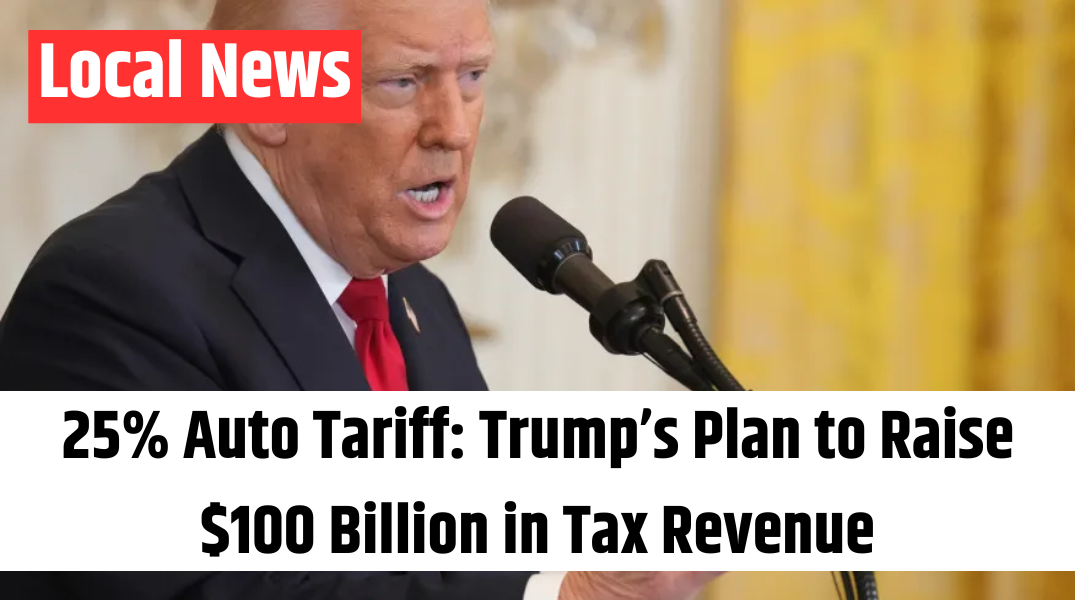
WASHINGTON, D.C. – President Donald Trump has announced a 25% tariff on imported vehicles and auto parts, a move he asserts will stimulate domestic manufacturing but may significantly impact global supply chains and consumer prices.
“This will drive economic growth,” Trump told reporters on Wednesday. “We’re implementing a 25% tariff on auto imports, effective next month.”
The White House anticipates the measure will generate $100 billion in annual revenue, but automakers warn of potential cost increases due to reliance on foreign-sourced components. As the tariff takes effect on April 3, industry experts predict rising production costs and possible declines in sales. Trump, however, maintains that this policy will encourage more factories in the U.S. and reduce dependency on international supply networks.
Impact on Automakers and Consumers
The announcement has already impacted the stock market, with General Motors’ shares dropping 3% and Stellantis, which owns Jeep and Chrysler, seeing a 3.6% decline. Ford, in contrast, experienced a slight stock increase. Analysts caution that the tariffs could add up to $12,500 to the price of an imported vehicle, pushing more consumers toward the used car market as affordability decreases.
Mary Lovely, an economist at the Peterson Institute for International Economics, criticized the policy, warning of higher vehicle costs, fewer choices for consumers, and a disproportionate burden on middle- and working-class households. With new car prices already averaging $49,000, further price hikes may make purchasing a new vehicle unrealistic for many Americans.
Global Response and Trade Tensions
The tariff decision has drawn swift backlash from international leaders. Canadian Prime Minister Mark Carney called the move a “direct attack”, vowing to protect Canadian workers and businesses. In Europe, European Commission President Ursula von der Leyen condemned the decision, emphasizing that tariffs harm both businesses and consumers on both sides of the Atlantic. The EU is now assessing potential retaliatory measures.
The new policy also includes an auto loan interest tax deduction for buyers purchasing U.S.-made vehicles, which could offset some of the increased costs. However, the White House has not clarified how this deduction will affect projected tariff revenues.
Tariff Coverage and Legal Justification
The tariffs will apply to both completed vehicles and auto parts, impacting manufacturers who rely on Mexican, Canadian, and Asian supply chains. The administration argues that excess production capacity in the U.S. will allow automakers to shift manufacturing domestically, avoiding the tariffs altogether.
Legally, the White House is invoking a 2019 Commerce Department investigation, which cited national security concerns as justification for trade restrictions. The United States-Mexico-Canada Agreement (USMCA) will exempt auto content produced in North America, but parts originating outside the region will still face the 25% tax.
Broader Economic and Trade Policy Shift
Trump’s decision is part of a broader effort to reshape U.S. trade policies. On April 2, he will impose reciprocal tariffs to match the taxes and duties charged by other nations. His administration has already implemented a 20% tariff on all Chinese imports in response to Beijing’s role in fentanyl production, alongside new taxes on steel, aluminum, semiconductors, pharmaceuticals, and energy imports from multiple countries.
The escalation has raised fears of a global trade war, with the EU considering a 50% tariff on U.S. spirits in response. Trump retaliated by proposing a 200% tax on European alcoholic beverages. Meanwhile, his administration has imposed new tariffs on oil imports from Venezuela, despite the U.S. continuing to purchase Venezuelan crude.
Economic and Industry Outlook
Trump pointed to Hyundai’s recent announcement of a $5.8 billion steel plant in Louisiana as evidence that tariffs are bringing jobs back to the U.S. Despite this, employment in domestic auto manufacturing remains 320,000 jobs below its 2000 levels, according to the Bureau of Labor Statistics.
The United States imported nearly 8 million vehicles worth $244 billion last year, with Mexico, Japan, and South Korea serving as the largest suppliers. Additionally, the country imported $197 billion in auto parts, primarily from Mexico, Canada, and China.
While the administration is optimistic about increased domestic production, industry experts stress that restructuring global supply chains and building new manufacturing facilities will take years—leaving both automakers and consumers to navigate the economic consequences in the meantime .







